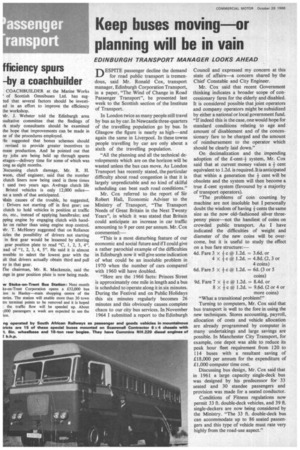Keep buses moving or planning will be in vain
Page 30

If you've noticed an error in this article please click here to report it so we can fix it.
EDINBURGH TRANSPORT MANAGER LOOKS AHEAD DESPITE passenger decline the demand for road public transport is tremendous, said Mr. Ronald Cox, transport manager, Edinburgh Corporation Transport, in a paper, "The Wind of Change in Road Passenger Transport", he presented last week to the Scottish section of the Institute of Transport.
In London twice as many people still travel by bus as by car. In Newcastle three-quarters of the travelling population go by bus. In Glasgow the figure is nearly as high—and again the same in Liverpool. In these towns people travelling by car are only about a sixth of the travelling population.
"All the planning and all the technical developments which are on the horizon will be wasted unless the bus can move. As London Transport has recently stated, the particular difficulty about road congestion is that it is largely unpredictable and no kind of skilful scheduling can beat such road conditions."
Mr. Cox referred to the report of Sir Robert Hall, Economic Adviser to the Ministry of Transport, "The Transport Needs of Great Britain in the Next Twenty Years", in which it was stated that Britain could anticipate an increase in car traffic amounting to 9 per cent per annum. Mr. Cox commented:— "This is a most disturbing feature of our economic and social future and if! could give a rather parochial example of the difficulties in Edinburgh now it will give some indication of what could be an insoluble problem in 1970 when the number of cars compared with 1960 will have doubled.
"Here are the 1966 facts: Princes Street is approximately one mile in length and a bus is scheduled to operate along it in six minutes. During the Festival and on Public Holidays this six minutes regularly becomes 26 minutes and this obviously causes complete chaos to our city bus services. In November 1964 I submitted a report to the Edinburgh Council and expressed my concern at this state of affairs—a concern shared by the Chief Constable and City Engineer.
Mr. Cox said that recent Government thinking indicates a broader scope of concessionary fares for the elderly and disabled. It is considered possible that joint operators and company operators might be subsidized by either a national or local government fund. "If indeed this is the case, one would hope for standard conditions relating to age and amount of disablement and of the concessionary fare to be charged and the amount of reimbursement to the operator which should be clearly laid down."
On decimalization and the impending adoption of the L-cent-+ system, Mr. Cox said that at current money values a + cent equivalent to 1.2d. is required. Itis anticipated that within a generation the 4cent will be obsolete and the system will then become a true f-cent system (favoured by a majority of transport operators).
"The problems of coin counting by machine are not insoluble but I personally doubt the wisdom of having + cents the same size as the now old-fashioned silver threepenny piece—not the handiest of coins on crowded public transport. As I have indicated the difficulties of weight and diameter of the new coins will be overcome, but it is useful to study the effect on a bus fare structure:— 4d. Fare 3 x +c @ 1.2d. = 3.6d. or 4 x c @ 1.2d. = 4.8d. (2, 3 or 4 coins) 6d. Fare 5 x @ 1.2d. = 6d. (3 or 5 coins) 9d. Fare 7 X 4c @ 1.2d. = 8.4d. or 8 X + c @ 1.2d. = 9.6d. (2 or 4 or more coins) "What a transitional problem!"
Turning to computers, Mr. Cox said that bus transport is well to the fore in using the new techniques. Stores accounting, payroll, allocation of costs and vehicle allocation are already programmed by computer in many undertakings and large savings are possible. In Manchester City Transport, for example, one depot was able to reduce its peak hour fleet requirement from 120 to 114 buses with a resultant saving of £18,000 per annum for the expenditure of £1,000 computer time cost.
Discussing bus design, Mr. Cox said that in 1961 a large capacity single-deck bus was designed by his predecessor for 33 seated and 30 standee passengers and provision was made for a seated conductor.
Conditions of Fitness regulations now permit 33 ft. double-deck vehicles, and 39 ft. single-deckers are now being considered by the Ministry. "The 33 ft. double-deck bus can accommodate up to 86 seated passengers and this type of vehicle must rate very highly from the road-use aspect."
























































































































